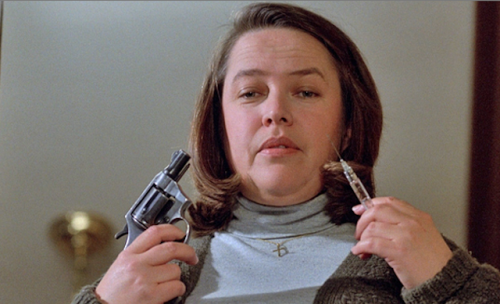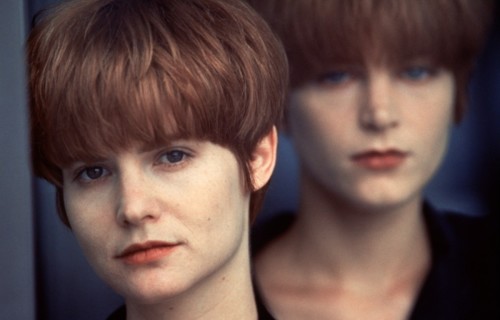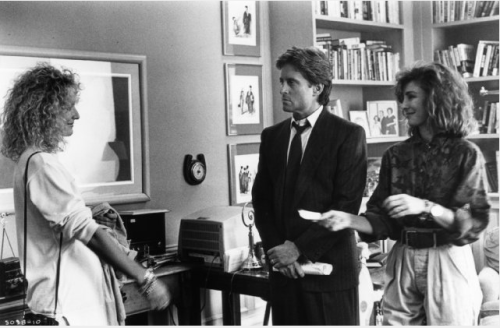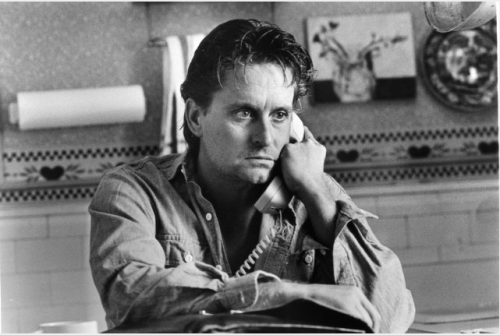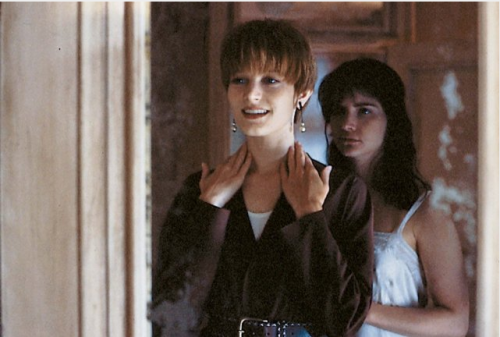This guest post by Tessa Racked appears as part of our theme week on Violent Women.
Content Note: This essay contains discussion of physical and emotional abuse.
Misery, directed by Rob Reiner, is the 1990 film adaptation of the 1987 Stephen King novel of the same name. The scenario is as chilling as it is simple: romance novelist Paul Sheldon (James Caan) is saved from a car accident during a blizzard by Annie Wilkes (Kathy Bates). He is trapped in her house due to his injuries; she has an unhealthy obsession with his novels and violent temper. Paul’s latest novel, on the verge of being published, ends with the death of her favorite character, the titular Misery. Annie is widely considered Kathy Bates’ breakout role; she won both an Oscar and a Golden Globe for her portrayal, and Annie is listed as 17th on American Film Institute’s list of top 100 villains.
King has explicitly stated that Misery is about his personal battle against addiction: “Annie was my drug problem, and she was my number-one fan. God, she never wanted to leave,” he said in an interview with The Paris Review. It also expresses King’s frustration with his career, feeling trapped in the horror genre. (Similarly, the film adaptation was a departure genre-wise for Reiner, who had until this point made more comedic, sentimental fare like The Princess Bride and When Harry Met Sally…) The bulk of the story is the conflict between Paul, who wants to move on from writing the Misery series, and Annie, who forces Paul to languish in that stage of his life due to her unwavering fixation with both the series and her own idea of who he is as an author. A flashback scene between Paul and his agent (Lauren Bacall) foreshadows his ordeal, as he explains his decision to end his popular romance novel series by killing off the protagonist: “if I hadn’t gotten rid of her now, I would end up writing her forever.” Annie’s prison from which Paul must escape is her home; the violence she enacts is twisted versions of caregiving and romance. Not only is the antagonist of Misery a woman, but her modes of terror are coded distinctly as feminine.
Misery is a departure from much of King’s earlier work (and the resulting film adaptations), as it is not a work of speculative fiction. Annie is a human being, dangerous not because of an evil supernatural force, but rather a severe and untreated mental illness. Although Annie is not given an official diagnosis in the film or the novel, an interview with a forensic psychologist on the special edition DVD characterizes her as displaying symptoms of several different conditions, including borderline personality disorder (BPD). BPD is commonly thought of as a mental illness that primarily affects women, who make up 75 percent of the diagnoses in the United States. However, this trend may be caused by gender biases in the mental health field for various reasons; some symptoms of BPD are similarly feminized (eg. a frequent co-occurence with eating disorders), while others are considered “normal” male behavior and therefore more pathologized in women (eg. promiscuity).
Misery is not the only thriller that dramatizes symptoms of BPD to create a female antagonist who becomes obsessed with someone she desires and terrorizes that person with emotional outbursts and impulsive, violent behavior. Consider Alex (Glenn Close) in Fatal Attraction (the highest grossing film of 1987), Hedy (Jennifer Jason Leigh) in Single White Female, or Evelyn (Jessica Walter) in Play Misty for Me, all of whom have been described as having BPD. Although they resemble each other as far as the threat they present their films’ protagonists, Annie is a markedly different sort of woman; in her own words, she is “not a movie star type.” Her clothing is plain and modest. She is older and larger-bodied than the other female villains. One of her most memorable characteristics is her frequent use of bowdlerized profanity, such as “dirty birdy” and “cockadoodie.” She is a hopeless romantic, but in short, she lacks sex appeal. Annie is also different in that she is coded as working class and rural. She lives by herself on a farm. She pays tribute to Paul by naming her sow after the literary heroine he’s created. (Misery is one cute pig, to be fair, but her captive seems less than flattered.) Her idea of a fancy dinner is making meatloaf with SPAM added in, and she mispronounces Dom Perignon. She contrasts sharply with, for instance, Fatal Attraction’s Alex, a sophisticated book editor who lives in New York City. Unlike Alex, Annie isn’t positioned as an exciting temptress, or an embodied punishment for lustful transgression. Rather, she is a smothering maternal figure, forcing Paul into an arrested state of mediocrity as a creative and infantilizing him as the helpless prisoner in her guest bedroom.
Although Annie talks about Paul both as the object of her romantic love and her literary idol, their relationship as portrayed in the film more closely resembles that of a mother and child. In their first interaction, Annie extracts an unconscious Paul from the wreck of his car, administers CPR, and carries him back to her home. In the next scene, we meet Annie as she gently reassures Paul that she is his “number-one fan” and that he’s going to be all right. Annie giving Paul life, bringing him into her home, and reinforcing to him that she is there to care for him because she loves him more than anyone else is strikingly similar to a basic narrative of a woman giving birth. Even the way the audience sees who she is for the first time is through visual and auditory tropes often used to convey a newborn baby: the scene is shot from Paul’s point of view, initially blurry and echoing, then coming into focus and resting on a low angle shot of Annie’s face. These low angle shots of Annie from Paul’s point of view are a recurring image in the film, often used when she spiraling out in an angry rant that hints at (or culminates in) the violence she is capable of enacting.
Annie’s treatment of Paul is nothing short of abusive, but also reinforces the maternal quality of her control over him. The harmful aspects of her caregiving are one of the main sources of horror in the film. She proudly shows off her nursing skills through the homemade braces she’s fashioned for his broken legs, as the camera pans down the horrific sight of his severe injuries that would normally be covered by casts. An early suggestion of menace comes when she coyly admits that she made pilgrimages to the lodge where he was working on his latest novel and would stand under his window, as she shaves him with a straight razor: “Like a baby!” she pronounces upon finishing both her task and her description of stalking him. This scene is followed by our first glimpse of her temper. She chastises Paul for his use of profanity in the manuscript he has allowed her to read– his first novel outside of the Misery series to be published– and her indignancy quickly grows into anger. She yells and spills the soup she is holding. “Look what you made me do!” she cries, showing both a mother’s frustration with a child making a mess and an abuser’s displacement of blame for their own actions.
Although she seems to be a simple person at first, her awareness of the situation’s dynamic is made abundantly clear after she flies into a rage over Paul’s latest published work, Misery’s Child, in which the main character dies. Not only is she distraught over losing Misery, but she is angry at Paul for defying her perception of him as an ever-obliging font of “genius” romance novels, or, as she describes it, being a “lying old dirty birdy.” She just barely prevents herself from smashing an end table over Paul’s head. Instead, she wields his dependency, and the potential removal of her love and care, as a threat: “don’t even think about anybody coming for you… nobody knows you’re here, and you better hope nothing happens to me, because if I die, you die.” Annie’s violent mothering reaches its summit in the dramatic reveal of her past: Paul discovers, through a remarkably convenient scrapbook that she keeps in her living room, that her nursing career was fraught with the mysterious deaths of infants in her care.
Although Annie enacts her relationship with Paul through caregiving, she is motivated by romance. It is evident from her perspective that she sees their relationship as a budding love story: when she is calm, she often talks to him in a shy, girlish manner, in awe of his “genius.” Once she manages to coerce him into writing a satisfactory retcon of Misery’s death, she celebrates by blasting Liberace records, as she considers his music to be very romantic. The subsequent montage of Paul feverishly working on Misery’s Return is set to Liberace’s rendition of Tchaikovsky’s dramatic “Piano Concerto Number 1.” Paul tries to escape by playing along with her, even suggesting they have a candlelit dinner together so that he will have an opportunity to drug her wineglass (which she clumsily knocks over during his toast, being unused to navigating a romantic setting like their dinner in the real world). After she murders the sheriff (Richard Farnsworth) investigating Paul’s disappearance, she informs her prisoner that their only option is a murder-suicide. However, she does so in rapturous tones, using language that could be lifted from a darker version of Paul’s own novels: “You and I are meant to be together forever. But now our time in this world must end.”
The relationship Annie wants to have with Paul is toxic, as it is based on her preventing him from growing/healing, from being his own person. She prevents him from physically walking away from her home, and she prevents him from professionally walking away from the Misery series. The infamous “hobbling” scene is a perfect illustration of how she objectifies Paul. Setting up the grisly procedure, she explains that it was how workers “in the early days of the Kimberley Diamond Mines” were punished for stealing, and how she will punish him for leaving his room. As she prepares to break his ankles with a sledgehammer, she blithely compares the victims of this procedure to cars and tells him that it’s “for the best,” dehumanizing him and denying the pain that she is about to put him through. The scene ends with the camera zooming in on her gazing down at the agonized Paul as she whispers, “God, I love you.”
In most horror films, the threat that the villain poses is annihilation: their aim is to maim and kill the protagonist. Annie’s goal is different. She too uses violence, but it is a tool that she wields to enforce a much different threat: inertia. She embodies this threat by adopting roles that are closely tied with femininity: she is the nurse who refuses to let her patient heal, the “mother” who prevents her “child” from gaining independence, the muse who forces her author to continue writing long after the story has concluded. The inability to grow is an obstacle that confronts people of all genders– after all, empowering women to transcend confining social roles is a ubiquitous concern among feminists– but Misery is an expression of this conflict as a potential threat that women pose men.
Recommended Reading:
“Borderline Personality Disorder- a Feminist Critique”
Tessa Racked lives in Chicago. They write essays about fat characters in cinema at Consistent Panda Bear Shape and make condensed observations about a variety of subjects @tessa_racked. Tessa celebrates the completion of every tweet with a cigarette and a glass of Dom Perignon.
